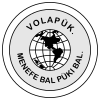Volapük
| Volapük | |
|---|---|

Logo of the Volapük movement (2nd phase)
|
|
| Created by | Johann Martin Schleyer |
| Date | 1879–1880 |
| Setting and usage | International: mostly in Europe |
| Users | 20 (2000) |
| Purpose | |
| Latin | |
| Sources | vocabulary from English, German, and French |
| Official status | |
| Regulated by | Kadäm Volapüka |
| Language codes | |
| ISO 639-1 | vo |
| ISO 639-2 | vol |
| ISO 639-3 | |
| Glottolog | None |
Volapük (/ˈvɒləpʊk/ in English;[volaˈpyk] in Volapük) is a constructed language, created in 1879–1880 by Johann Martin Schleyer, a Roman Catholic priest in Baden, Germany. Schleyer felt that God had told him in a dream to create an international language. Volapük conventions took place in 1884 (Friedrichshafen), 1887 (Munich) and 1889 (Paris). The first two conventions used German, and the last conference used only Volapük. In 1889, there were an estimated 283 clubs, 25 periodicals in or about Volapük, and 316 textbooks in 25 languages; at that time the language claimed nearly a million adherents. Volapük was largely displaced in the late 19th and early 20th centuries by Esperanto.
Schleyer first published a sketch of Volapük in May 1879 in Sionsharfe, a Catholic poetry magazine of which he was editor. This was followed in 1880 by a full-length book in German. Schleyer himself did not write books on Volapük in other languages, but other authors soon did.
André Cherpillod writes of the third Volapük convention,
In August 1889 the third convention was held in Paris. About two hundred people from many countries attended. And, unlike in the first two conventions, people spoke only Volapük. For the first time in the history of mankind, sixteen years before the Boulogne convention, an international convention spoke an international language.
...
Wikipedia
